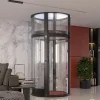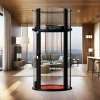Choosing the right elevator for your building is a crucial decision that affects not only the convenience and comfort of its occupants but also the overall value and functionality of the property. Whether constructing a new building or retrofitting an existing one, understanding the different types of elevators and their features can help you make an informed choice.
Understanding Elevator Types
- Passenger Elevators
Passenger elevators are the most common type, designed to transport people between floors. They come in various sizes and capacities, making them suitable for residential buildings, commercial spaces, and public facilities.
Cargo elevators, often referred to as freight elevators, are built to carry heavy loads and goods. They are essential in warehouses, factories, and any building where the transportation of heavy items is necessary.
- Service Elevators
Service elevators are similar to passenger elevators but are used by staff and service personnel. They are typically found in hotels, hospitals, and large commercial buildings.
- Dumbwaiters
Dumbwaiters are small elevators used to transport food, laundry, and other small items between floors. They are common in restaurants, hotels, and hospitals.
- Home Elevators
Home elevators, designed for residential use, provide convenience and accessibility in multi-story homes. They are often chosen for luxury homes or for accessibility purposes, similar to passenger elevators.
Key Considerations When Choosing an Elevator
- Building Type and Usage
The type of building and its usage significantly influence the choice of an elevator. For instance, a high-rise office building will require high-speed passenger elevators, while a warehouse will need heavy-duty cargo elevators. Understanding the building’s daily traffic patterns helps determine the appropriate capacity and speed for the elevator.
- Capacity and Speed
Determine the required capacity and speed based on the building’s occupancy and traffic patterns. High-traffic buildings need elevators with higher capacities and faster speeds to reduce waiting times and improve efficiency. For residential buildings, a moderate speed and capacity might suffice, while commercial buildings may require higher performance specifications.
- Energy Efficiency
Energy-efficient elevators reduce operating costs and are better for the environment. Look for elevators with regenerative drives, LED lighting, and sleep modes that conserve energy when the elevator is not in use. Energy efficiency not only lowers utility bills but also contributes to sustainable building practices.
- Safety Features
Ensure the elevator has essential safety features such as emergency brakes, backup power systems, and modern control systems. Regular maintenance and compliance with safety standards are crucial to prevent accidents and ensure reliable operation. Features like automatic rescue devices and fire-rated doors enhance the safety of the elevator system.
- Design and Aesthetics
The design and aesthetics of the elevator should complement the building’s interior. Many companies offer customizable options to match the building’s decor, including materials, finishes, and lighting. A well-designed elevator can enhance the overall aesthetic appeal and value of the building.
- Maintenance and Support
Consider the availability of maintenance and support services when choosing an elevator. Reliable and prompt maintenance services are essential for minimizing downtime and ensuring the longevity of the elevator system. Choose an elevator that comes with a comprehensive maintenance plan to ensure consistent performance.
- Technological Advancements
Modern elevators come equipped with advanced technologies that improve efficiency and user experience. Features such as destination control systems, touchless operation, and smart sensors enhance the functionality and convenience of the elevator. Staying updated with the latest technological trends can ensure that your building remains state-of-the-art.
- Compliance with Regulations
Ensure that the chosen elevator complies with local building codes and regulations. This includes adhering to safety standards, accessibility requirements, and environmental guidelines. Compliance not only ensures the safety of occupants but also avoids legal complications.
Conclusion
Choosing the right elevator for your building involves careful consideration of various factors, including the type of building, capacity, speed, energy efficiency, safety features, design, maintenance, technological advancements, and regulatory compliance. By understanding these key elements, you can make an informed decision that enhances the functionality, safety, and appeal of your building.
Investing in the right elevator system is crucial for providing smooth, safe, and efficient vertical transportation, contributing to the overall success and value of your property. Make sure to evaluate your specific needs and preferences to choose an elevator that best fits your building’s requirements.








